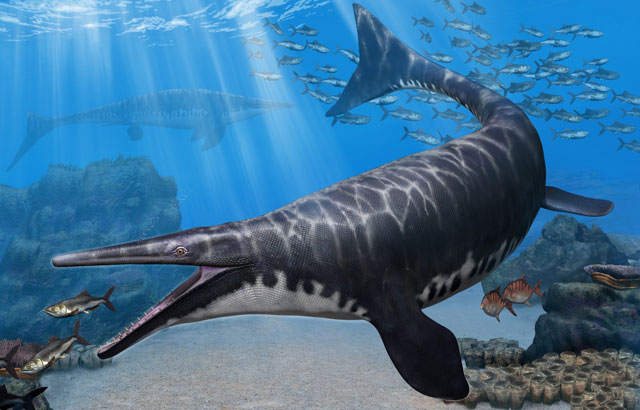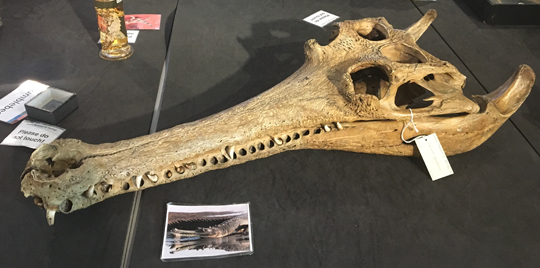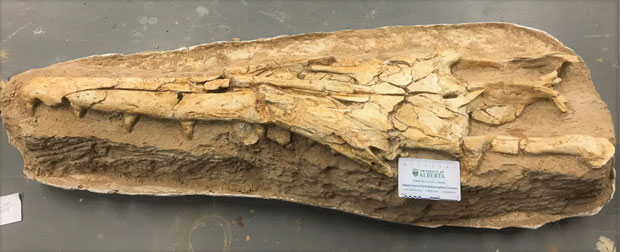A New Species of Mosasaur from Morocco
Gavialimimus almaghribensis – Specialised Piscivore from Morocco
An international team of researchers including scientists from the University of Alberta, the University of Cincinnati (USA) and Flinders University (Adelaide, Australia), have identified a new species of marine reptile from fossil remains found in Upper Cretaceous rocks from Morocco. The animal, a new species of mosasaur has been named Gavialimimus almaghribensis, its long, narrow snout and interlocking teeth suggest that it specialised in hunting fast-swimming, bony fish.
Gavialimimus almaghribensis
These adaptations suggest that this carnivore, distantly related to modern snakes and lizards, occupied a specific niche in the Moroccan marine ecosystem. Around a dozen different species of mosasaur are known from the Upper Cretaceous of Morocco, many with different shaped jaws and teeth. This suggests that these reptiles diversified rapidly during the Late Cretaceous and adapted to differing roles in the ecosystem to avoid direct competition with each other. The researchers writing in the “Journal of Systematic Palaeontology” suggest that these are examples of niche partitioning in the ancient environment.
A Life Reconstruction of the Newly Described Gavialimimus almaghribensis

Picture credit: Tatsuya Shinmura
Corresponding author for the scientific paper, Catherine Strong (University of Alberta), stated:
“Its long snout reflects that this mosasaur was likely adapted to a specific form of predation, or niche partitioning, within this larger ecosystem. For some species, these adaptations can be very prominent, such as the extremely long snout and the interlocking teeth in Gavialimimus, which we hypothesised as helping it to catch rapidly moving prey.”
Resembling a Gavial (Gavial Mimic)
The genus name means “Gavial mimic”, a reference to the similarity between the jaws and dentition of this mosasaur to that of the extant long-snouted gavial (gharial). Whilst the trivial or species name is derived from the Romanised version of the Arabic term for Morocco (al-Maghrib) paired with the Latin suffix “ensis”, thus denoting the country of origin of the holotype.
The Skull of a Gharial (Gavial)

Picture credit: Everything Dinosaur
From the Oulad Abdoun Basin
The fossils, including a metre-long skull come from the upper Maastrichtian deposits of the Oulad Abdoun Basin of northern Morocco. The phosphate mines in this region are a rich source of mosasaur fossils and occasionally a dinosaur or two: The Last Dinosaur from Africa.
These sediments have revealed new species of pterosaur too: Pterosaurs More Diverse at the End of the Cretaceous than Previously Thought.
The Fossilised Skull of the Newly Described Gavialimimus almaghribensis
Picture credit: Catherine Strong (University of Alberta)
Everything Dinosaur acknowledges the assistance of a media release from the University of Alberta in the compilation of this article.
The scientific paper: “A new species of longirostrine plioplatecarpine mosasaur (Squamata: Mosasauridae) from the Late Cretaceous of Morocco, with a re-evaluation of the problematic taxon ‘Platecarpus’ ptychodon” by Catherine R. C. Strong, Michael W. Caldwell, Takuya Konishi and Alessandro Palci published in the Journal of Systematic Palaeontology.
The Everything Dinosaur website: Everything Dinosaur.


